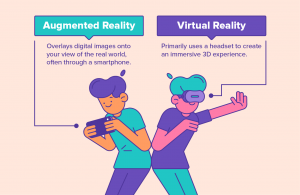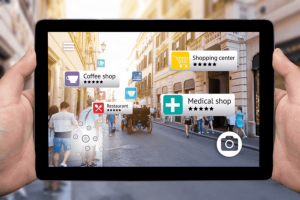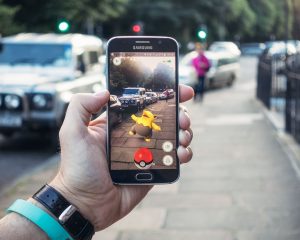
Shownotes
Welcome to Day 1433 of our Wisdom-Trek, and thank you for joining me.
This is Guthrie Chamberlain, Your Guide to Wisdom
Augmented Reality - How Will It Impact Our World – Ask Gramps
Wisdom - the final frontier to true knowledge. Welcome to Wisdom-Trek! Where our mission is to create a legacy of wisdom, to seek out discernment and insights, to boldly grow where few have chosen to grow before. Hello, my friend, I am Guthrie Chamberlain, your captain on our journey to increase Wisdom and Create a Living Legacy. Thank you for joining us today as we explore wisdom on our 2nd millennium of podcasts. Today is Day 1433 of our Trek, and our focus on Fridays is the future technological and societal advances, so we call it Futuristic Fridays. My personality is one that has always been very future-oriented. Since my childhood, I have yearned for the exploration and discovery of new technologies and advancements for the future. I grew up with the original Star Trek series, and even today, while I am on my 64th revolution around the sun, I still dream of traveling in space. Each week we will explore rapidly converging technologies and advancements, which will radically change our lives. At times, the topics may sound like something out of a science fiction novel, but each area that we explore is already well on its way of becoming a reality over the next couple of decades.
To keep with our theme of “Ask Gramps,” I will put our weekly topics in the form of a question to get us on track. So this week’s question is: Hey Gramps, what is Augmented Reality, and how will it impact our world in the future?
Augmented Reality – How It Will Impact Our World
Last week on Futuristic Friday, we explored how Sensors and the Internet of Things (referred to as IoT) will track and measure all types of information in every aspect of our lives. Augmented Reality (or AR) will be one of the connections or sensors which will provide information to and from our world. Our world is in a disruptive mode, which will speed up the exponential technology that is changing our world today. I am using some of the information mentioned in Peter Diamandis’s blogs and book “The Future is Faster Than You Think.”
Augmented Reality is about to add a digital intelligence layer to our every surrounding, transforming retail, manufacturing, education, tourism, real estate, and almost every major industry that holds up our economy today.
Apple’s Tim Cook has remarked, “I regard [AR] as a big idea like the smartphone. The smartphone is for everyone. We don’t have to think the iPhone is about a certain demographic, or country, or vertical market. It’s for everyone. I think AR is that big; it’s huge.”
Apple, Microsoft, Google Alphabet, Amazon, and numerous other players are entering this AR market, so we are on the cusp of witnessing a newly augmented world.
In one of the most significant technological revolutions of this century, smartphones have dematerialized cameras, stereos, video game consoles, TVs, GPS systems, calculators, paper, and even matchmaking as we knew it.
AR glasses will soon perpetuate this, ultimately dematerializing the smartphone itself. We will no longer gaze into tiny, two-dimensional screens but rather see through a fully immersive, 3D interface.
· Introducing the Augmented World
While already beginning to permeate mobile applications, AR will soon migrate to headsets, and eventually reach us through contact lenses — replacing over 3 billion smartphones in use today.
AR superimposes digital worlds onto physical environments (by contrast to VR, which completely immerses users in digital realities). In this way, AR allows users to remain engaged with their physical surroundings, serving as a visual enhancement rather than replacement.
As AR hardware costs continue to plummet — and advancements in connectivity begin enabling low-latency, high-resolution rendering — today’s AR producers are initially targeting businesses through countless enterprise applications.

While AR headsets remain too pricey for widespread consumer adoption, distribution is fast increasing. Roughly 150,000 headsets were shipped in 2016, and this number is expected to reach 22.8 million by 2022.
Meanwhile, AR app development has skyrocketed, allowing smartphone users to sample rudimentary levels of technology through numerous mobile applications. Already, over 1 billion people across the globe use mobile AR, and a majority of mobile AR integrations involve social media (84%) and e-commerce (41%).
Yet while well-known players like Microsoft, Apple, Google Alphabet, Amazon, Qualcomm, Samsung, NVIDIA, and Intel have made tremendous strides, well-funded startups remain competitive.
While AR isn’t (yet) as democratized as VR, $100 will get you an entry-level Leap Motion headset, while a top-of-the-line Microsoft HoloLens 2 remains priced at $3,500. However, heads-up-displays in luxury automobiles — arguably the first AR applications to go mainstream — will soon become a standard commodity in economic models.
As corporate partnerships with AR startups grow increasingly common, the convergence of augmented reality with sensors, networks, and IoT will transform almost every industry imaginable.
· A Taste of Industry Transformations
In Manufacturing & Industry, AR training simulations are already beginning to teach us how to operate numerous machines and equipment, even to fly planes. Microsoft, for instance, is targeting enterprise clients with its HoloLens 2, as the AR device’s Remote Assist function allows workers to call in virtual guidance if unfamiliar problems arise in the manufacturing process.
Healthcare: AR will allow surgeons to “see inside” clogged arteries, provide precise incision guides, or flag potential risks, introducing seamless efficiency in everything from reconstructive surgeries to meticulous tumor removals. Medical students will use AR to peel back layers on virtual cadavers. And in everyday health, we will soon track nearly every health and performance metric — whether heart rate, blood pressure, or nutritional data — through AR lenses (as opposed to wearables).
Education: In our classrooms, AR will allow children (and adults alike!) to explore both virtual objects and virtual worlds. But beyond the classroom, we will have the option to employ AR as a private teacher wherever we go. Buildings will project their history into our field of view. Museums might have AR-enhanced displays. Every pond and park will double as a virtual-overlaid lesson in biology and ecology. Or teach your children the value of money with virtual budgeting and mathematical tabulations at grocery and department stores. Already, apps like Sky Map and Google Translate allow users to learn about their surroundings through smartphone camera lenses, and AR’s teaching capabilities are only on the rise.
Yet Retail & Advertising take AR’s transformative potential to a new level. Hungry and on a budget? Your smart AR contact lenses might show you all available lunch specials on the block, cross-referenced with real-time customer ratings, special deals, and your own health data for individualized recommendations. Storefront windows will morph to display your personalized clothing preferences, continuously tracked by AI, as eye-tracking technology allows your AR lenses to project every garment that grabs your attention onto your form, in your size. Smart AR advertising — if enabled — will target your every unique preference, transparently informing you of comparable, cheaper options the minute you reach for an item.
And in Entertainment, we will soon be able to toggle into imaginary realities, or even customize physical spaces with our own designs. 3D creations will become intuitive and shareable. Sports player stats will be superimposed onto live sporting events, as spectators recreate immersive stadiums with front-row seats in their own backyards. Turn on game mode, and every streetside, park, store, and neighborhood merges into a virtually overlaid game, socially interactive and interspersed with everyday life.
In Transportation, AR displays integrated in-vehicle windows will allow users to access real-time information about the restaurants, stores, and landmarks they pass. Walking, biking, and driving directions will be embedded in our routes through AR. And when sitting in your autonomous vehicle-turned office on the way to work, AR will have the power to convert any vessel into a virtual haven of your choice.

Welcome to the augmented world of 2030.
· Final Thoughts
While enterprises are fueling the initial deployment of AR headsets for employee training and professional retooling, widespread consumer adoption is fast reaching the horizon. As hardware and connectivity skyrocket, driving down prices and democratizing access, sleek AR glasses — if not dematerialized lenses — will become an everyday given.
Advancements in cloud computing and 5G coverage are making AR products infinitely more scalable, ultra-fast, and transportable.
Yet ultimately, AR will give rise to neural architectures directly embedded through brain-computer interfaces. Our mode of interaction with the IoT will evolve from smartphone screens, to AR glasses, to contact lenses, to BCIs.
Over the next few ‘Futuristic Fridays,’ we will learn the ins and outs of AR technology before it initiates a revolutionary shift across every known industry, not to mention countless new ones.
There is a reality as Christ-followers that we have yet to experience. When Christ appears, our reality will be augmented with the truth, as we will see clearly.
Dear friends, we are already God’s children, but he has not yet shown us what we will be like when Christ appears. But we do know that we will be like him, for we will see him as he really is.
That is a wrap for today’s question. Join us again next Futuristic Friday for another interesting question about our future on our ‘Ask Gramps’ episode. Our next trek is Meditation Monday, where we will help you reflect on what is most important in life. So encourage your friends and family to join us and then come along on Monday for another day of ‘Wisdom-Trek, Creating a Legacy.’

If you would like to listen to any of the past 1432 daily treks or read the associated journals, they are all available at Wisdom-Trek.com. I encourage you to subscribe to Wisdom-Trek on your favorite podcast player so that each day will be downloaded to you automatically.
Thank you for allowing me to be your guide, mentor, and, most of all, your friend as I serve you in through this Wisdom-Trek podcast and journal.
As we take this Trek of life together, let us always:
- Live Abundantly (Fully)
- Love Unconditionally
- Listen Intentionally
- Learn Continuously
- Lend to others Generously
- Lead with Integrity
- Leave a Living Legacy Each Day
I am Guthrie Chamberlain….reminding you to ’Keep Moving Forward,’ ‘Enjoy your Journey,’ and ‘Create a Great Day…Everyday’! See you on Monday!